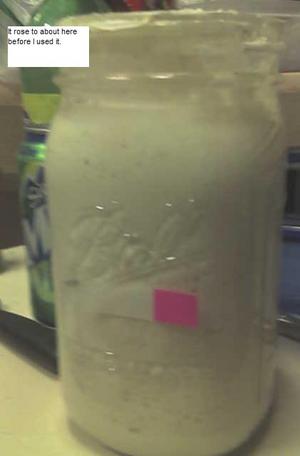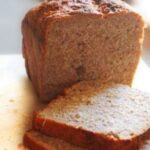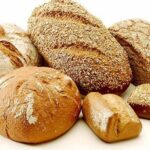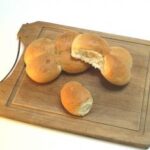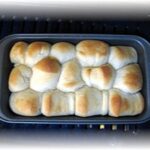Last Thanksgiving, I bought a loaf of sourdough bread. Me being me, and in one of thosemoods, I wondered, “how hard would it be to make it?” I knew that to make sourdough you needed sourdough starter (also known as wild-yeast). But, my ADD mind said there must be a way to make it. So, I surfed my way through the Internet, site after site, until I found one that gave me the remarkable recipe for sourdough starter. Are you ready for it? Here it is:
The magic recipe for sourdough starter is flour and water.
Yes, dear readers. Sourdough starter is nothing more than flour and water. Those two things, plus time, and lots and lots of patience, make sourdough starter.
Oh, did I forget to mention the air?
Air has a great deal to do with the flavor of your starter. Every location on earth gives starter a different flavor. Have you ever had San Francisco sourdough bread? Well, you will never have it any where else on earth unless the bread you eat was made with starter started in San Francisco. The wild yeast that thrives in the air you breath gives your starter, and so your bread, a unique flavor. Unique to where you live. The bread I make with starter made (read wholly originated) in the Rockies is not going to taste the same as bread made in Jacksonville, Florida, or Lexington Park, Maryland. Recently, my sister gave me starter given to her by a friend from New England. It will have the taste of Vermont sourdough, although made in Colorado.
The fact that the starter is here (we’ll work with Colorado for the moment) and fed here makes it Colorado starter. After awhile I won’t be able to say it is Vermont starter. Chances are, once upon a time, the starter in San Francisco didn’t start in San Francisco. What is important is that wherever your starter is…wherever you are feeding this starter…it becomes YOUR starter.
For the beginner, use unbleached white flour or unbleached bread flour. I will explain more about flour later. Basically, this is what you do.
Day 1: Mix equal amounts of flour and water (amounts don’t really matter…could be a couple of teaspoons of each or a quarter cup of each). Keep it covered (I use plastic wrap or a snack-size baggy), but not air-tight. I live in Colorado at an altitude of over 6,000 feet, so I have to add more water otherwise my starter is quite dry. In the end, the texture/moisture level is up to you, the baker. Some prefer it very thick, some prefer it wetter, what serious bread bakers refer to as hydration. To determine the percentage of hydration, divide the amount of water by the amount of flour used. (289 water/482 flour = 60%)
Day 2: Add the same amount of each as the day before. Mix together. Don’t worry if there are lumps. It will all work out in the end.
Day 3: Dump half of your mixture. Then mix in the same amounts of flour and water as before. Keep in mind altitude does matter. This is called feeding your starter. Some even name them. If I named my first one, it would have been Pokey because it took so long to get started.
Important note here: When you dump it, don’t send it down the toilet or sink. I hear it does nasty things to the pipes, like clog them up. Remember papier-mâché paste? Flour, water, and sugar? Makes a nice hard surface when it dries. We don’t want that in our pipes. Too bad I learned that after I dumped quite a bit down my drain. Just pour it in the trash. No matter the consistency, it’s going to dry. If that bothers you, put it in an old can, like you would bacon grease. When it dries, dump it.
Everyday do the same as you did on Day 3. Some folks say mix it every 12 hours, some say feed it every 12 hours. At the very minimum, feed it daily. In the end it should smell sour and kind of yeasty, be really bubbly, and it will have doubled in volume. If you find liquid at the top (I’ve had some on the bottom), don’t drain it, just mix it in. This is called hooch. The longer your starter does its thing the stronger the sour flavor you will get. Keep this in mind when it comes time to bake.
It will probably take a week, possibly even more, before it is ready to bake with. It took me almost two weeks before I got a good starter. Of course, I dumped it all a couple of times because I thought I was doing it wrong. This is where the patience comes in.
I use a mason jar so I can mark it and see clearly how it’s doing. As mentioned before, you can use just about anything, but any kind of metal isn’t recommended. It can give the yeast an off flavor. When I use a Ball mason jar, I mark it with a grease pencil. With Kerr, I put a piece of masking tape. Grease pencil doesn’t work well with Kerr jars.
When it comes to starter, you may find those who say speed up the process with commercial yeast. Don’t say that too loud around serious sourdough bakers. That is blasphemy to the serious bread baker.
For the serious bread baker, starter is a serious thing. Friends share with friends and family, families pass it down from generation to generation. I don’t mean the recipe, I mean the starter itself. The stuff I got from my sister is said to be 250 years old. You just need a little, like a teaspoon, even less, feed it a few days, and voila. You have starter for a fresh loaf of bread. Remember, commercial yeasts were not always around. Settlers coming west couldn’t stop at a Safeway on the way to pick some up. They brought it with them, probably obtained from the wife’s mother. The wife would pass it down to her daughter when she married, and on and on. Different locations produce different flavors of starter. San Francisco is very popular, but it can not be reproduced without starting with starter from San Francisco. I don’t know the science of it, but it has to do with the air. There are many sites on the Internet that sell starters. There is even one that gives it away. It usually come dried. You could even hit up your local baker. There’s a new baker near me, and I am very tempted to ask for some just to see what he/she says. I would imagine they’d give it out to anyone who asks because it is their starter. It can be a very personal thing. It didn’t grow in the ground, and you didn’t buy it at a store. You made it with flour, water, and air. Well, you might have bought some dried from someone or it was given to you, but hell, you nurtured it, fed it, and made it what it is today. Let it be yours.
Which leads me to the sometime baker. If you don’t bake daily, when your starter is fully developed, you can put it in the refrigerator and feed it weekly, the same as you did to start it. Dump half, add more water and flour, stir. If you bake even less frequently, spread a thin coat on a piece of wax paper, put it in the oven with the light on to generate heat. Leave it until it is dry. Store it in the freezer in a plastic bag. When it’s time to bake, reconstitute it with water, then feed it as you would any starter (as you did when you first started your starter) until you have enough for your recipe. Starting with dry starter is faster than starting from scratch as it is already active yeast. It just needs to be built up, which is why bakers in the know call them builds. On www.thefreshloaf.com you can get a spreadsheet for determining quantities and how many builds are needed. This is for the serious bread baker.
Along with sourdough starter, there is the pre-ferment, pâte fermentée, poolish, biga, and the barm (wet starter). Basically, they increase the flavor of the bread. Similar to sourdough starter, they are doughs of varying consistencies that have been left to rise (double in volume) for a period of time, usually from a couple of hours to a day or more. As with bread recipes, these recipes vary from baker to baker, and they do contain commercial yeast.
A note about commercial yeasts. Bread yeasts and rapid rise yeasts such as Fleischmann’s RapidRise are the same. Why they call them different names, I don’t know. These yeasts are different than regular active yeast. With active yeast, you must mix it with warm water and let it rise for a time. Bread yeasts don’t require that. And, you use less of it than active yeast.
More about flour. There are a lot of different types of flour. White bleached, white unbleached, unbleached bread flour, bleached bread flour, rye, wheat, and some I have never even heard of. As I mentioned earlier, for the beginner, use unbleached white or bread flour. There is something about the bleaching process the deteriorates the gluten which is key to starter, and dough in general. I once bought two ten-pound bags of white bleached flour. My ADD mind at work yet again. I wasn’t paying attention. I fed my starter religiously. It would double for a very short time then go flat. I posted a question on www.thefreshloaf.com. The response I received was try it. It’ll probably be okay. I did, and it was. I don’t know if it was because it was bleached or what. I think that flour is like every other food that is made by a manufacturer. Sometimes you just get bad batches. I haven’t tried the second bag. It might give me fine results.
Many recipes call for cups of flour and teaspoons and tablespoons of other dry ingredients. However, it is wise to weigh those ingredients in metric weight (i.e., grams). Besides allowing ease in figuring hydration, all dry ingredients do not weigh the same.
A teaspoon of salt weighs 5 g
A cup of all purpose unbleached flour weighs 142 g
A cup of bread flour weighs 156 g
A cup of whole wheat flour weighs 144 g
A cup of rye flour weighs about 130 g
I have given you the very basics of making sourdough starter. There are dozens of websites, and books for that matter, that you can turn to for advice. A favorite website of mine is www.thefreshloaf.com. Another is www.sourdoughhome.com. At www.thefreshloaf.com you can register and ask all the questions you like. You will receive a plethora of information, including how yeast and gluten work, which is possibly more then you really wanted to know about baking bread. They also provide recommendations for books and other websites. One popular book is The Bread Baker’s Apprentice by Peter Reinhart. It is for the true beginner and has illustrations to help guide you along.
Try making sourdough starter. If that’s too much for you, order it on line. Hell, ask your neighborhood baker. If you’re not into sourdough, there are dozens of types of breads that don’t require starter. Even if you live a mile above sea level or more, give it a try. When you get a good result, the taste cannot compare.
Sources:
Kendall, Patricia., ed. High Altitude Baking. Denver: 3D Press, Inc., 2003.
Reinhart, Peter. The Bread Baker’s Apprentice. Berkeley: Ten Speed Press, 2001.
